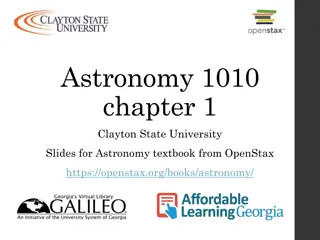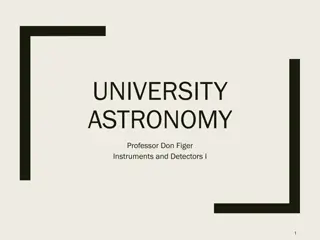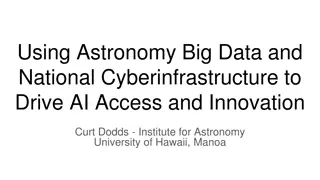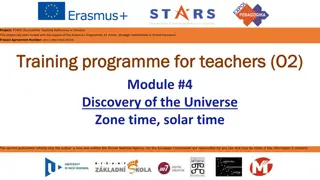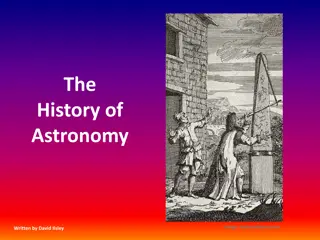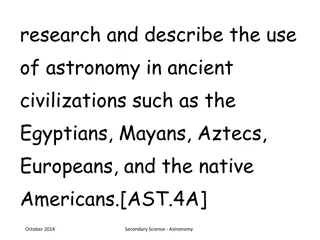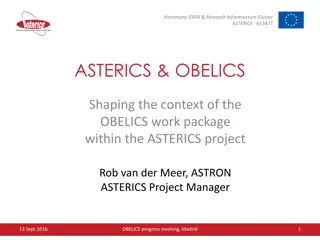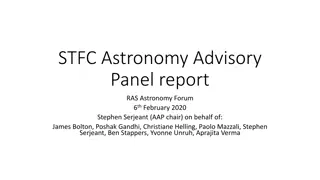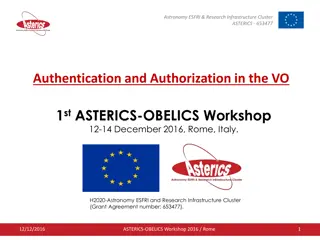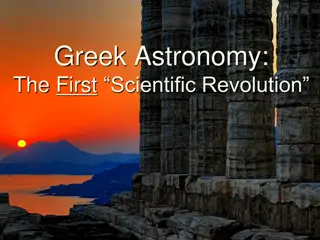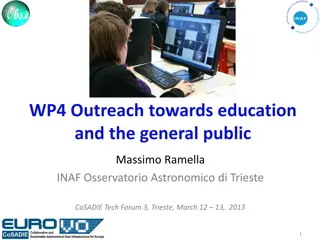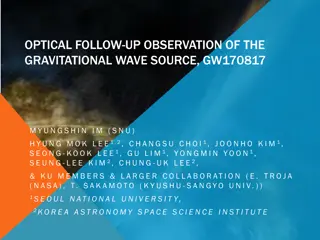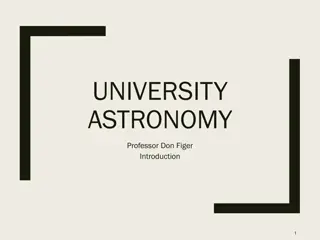UNIVERSITY ASTRONOMY
Delve into the fascinating realm of cosmology as we unravel the mysteries of the Universe, from its origins with the Big Bang theory to the accelerating expansion and potential fate of the cosmos. Discover the history of cosmological thought, from Aristotle to Newton, and ponder profound questions about the nature of our existence and the vast cosmos that surrounds us.
Download Presentation

Please find below an Image/Link to download the presentation.
The content on the website is provided AS IS for your information and personal use only. It may not be sold, licensed, or shared on other websites without obtaining consent from the author.If you encounter any issues during the download, it is possible that the publisher has removed the file from their server.
You are allowed to download the files provided on this website for personal or commercial use, subject to the condition that they are used lawfully. All files are the property of their respective owners.
The content on the website is provided AS IS for your information and personal use only. It may not be sold, licensed, or shared on other websites without obtaining consent from the author.
E N D
Presentation Transcript
UNIVERSITY ASTRONOMY Professor Don Figer Cosmology 1
Aims and outline for this lecture describe cosmological observations (23.1) describe the big bang theory and its predictions (24.3) show evidence for acceleration of the Universe (24.1) speculate on fate of the Universe 2
Definition of Cosmology Cosmology is the study of the Universe. More precisely it is the study of causes and effects related to the largest structures in the Universe. formation of matter/energy (from subatomic particles) distribution of matter/energy (into galaxies) evolution of matter/energy (from subatomic particles to heavy elements in stars) The word cosmology comes from the Greek words kosmo (world) and logia (study of). Motivating questions include: Was there a beginning to the Universe? Will there be an end to the Universe? Why does matter exist? 4
HISTORY OF COSMOLOGY
History of Cosmology to Newton Ptolemy thought that the Earth was the center of Universe that orbited around it. Copernicus thought that the Sun was center of the Universe. Newton proposed that celestial bodies obeyed the law of gravitation, just as do bodies on Earth. 8
Newtonian Cosmology Newton s Philosophiae Naturalis Principia Mathematica, 1687 Newtonian gravity, F = GMm/r2, and second law, F = ma Approximate size of solar system from parallax of Mars (Cassini, 1672) Finite speed of light from timing of Jupiter s moons (Ole R mer, 1676) Did not have distances to stars Did not know about galaxies 9
Olbers Paradox Heinrich Olbers wrote a paper in 1826 asking why the night sky is dark. An infinite number of stars should produce an infinitely bright night (and day!) sky. The resolution comes from the fact that there aren t an infinite number of stars that we can see and that some of the starlight is redshifted. This is one of the earliest cosmological observations. 12
History of Cosmology to Shapley Einstein extended Newton s idea by proposing that all laws of nature are the same everywhere. This means that the speed of light is constant. de Sitter, Schwarzschild, Eddington, and Friedmann introduced an expanding/accelerating Universe with matter in it. Shapley thought the Universe consisted only of just the Milky Way, but Curtis disagreed (and was right). 13
History of Cosmology to Now Lemaitre proposed the Big Bang Theory (but not the TV show, thus severely limiting his royalties/residuals). Hubble discovered his redshift-distance law. Penzias and Wilson discovered background radiation leftover from the Big Bang, but thought it was bird poop at first. It was not poop, so they won a Nobel Prize! COBE measured the background radiation another Nobel Prize! Schmidt, Riess, and Perlmutter detected that the expansion of the Universe is increasing another Noble Prize! 14
COSMIC MICROWAVE BACKGROUND
CMB The Cosmic Microwave Background (CMB) is background radiation observed from all directions in the sky. Penzias and Wilson found it in 1965. The radiation is fit by a black body with T=2.725 K. The average energy of a CMB photon is ~meV and the peak wavelength is ~1 mm. 17
Recombination At one point in the early Universe, the temperature was high enough so that all the hydrogen was ionized. This means that the Universe was flooded with free electrons. Free electrons scatter photons, so the photons were constantly being redirected. The effect of this is that the Universe was opaque. At a certain temperature (~3,000 K), the electrons and protons recombined. Thus, the Universe became transparent. At this point, photons decoupled from matter and freely traveled to space, where we now see them as the cosmic microwave background (redshifted to mm wavelengths). 18
Last Scattering The CMB photons that we now see were last scattered at the time of recombination. This corresponds to a redshift of 1,100. According to the most accepted model, the Universe was about 400,000 years old at this time. 19
CMB Cooling 20
COBE Map 21
EXPANSION OF THE UNIVERSE AND THE BIG BANG THEORY
Hubbles Law Hubble estimated distances to galaxies in his sample (underestimating them considerably) and saw that the velocities were proportional to the distances. Hubble s law is the relationship between distance and redshift for a galaxy. Recall that redshift is z= 0=v/c. The law is cz=H0d=v, where c is the speed of light, H0 is Hubble s constant, and d is the distance to the galaxy. H0 is ~70 +/-5 km/s/Mpc. (There appears to be a discrepancy between estimates for the Hubble Constant from two different methods, but they are similar to within ~5%.) 30
Big Bang This calculation is the basis for a big bang theory. That is, by projecting the expansion backward, we can imagine that there was a time when all matter was in a dense state. We call the quantity, 1/H0the Hubble time. It is the approximate age of the Universe. 32
BIG BANG NUCLEOSYNTHESIS
Big Bang Nucleosynthesis The Universe was so hot around the time of the Big Bang that atomic nuclei did not exist. Matter existed as a sea of protons and neutrons. This matter built up light elements as it cooled (allowing protons and neutrons to recombine). The standard model predicts that the Big Bang produced 75% H and 24% He and very little of anything else. Those ratios are generally observed, representing a great success for the Big Bang standard model. 34
ACCELERATION OF THE UNIVERSE
Acceleration The universe is expanding at a higher rate with time. This effect was discovered during 1998, by two independent projects, the Supernova Cosmology Project and the High-Z Supernova Search Team. Both teams used distant Type Ia supernovae to measure the acceleration. The technique measures brightness and z for each supernova. Assuming that Type Ia are the same everywhere ( standard candle ), then the distance modulus should simply be a function of distance. If z is only a function of distance, then the relation between m-M and z should be linear. Unexpectedly, the relation is not linear. Confirmatory evidence has been found in baryon acoustic oscillations, and in analyses of the clustering of galaxies. The accelerated expansion of the universe is thought to have begun since the universe entered its dark-energy-dominated era roughly 5 billion years ago. 41
Dark Energy Dark Energy is the name given to the thing that is causing the Universe to accelerate. Einstein originally included it in his equations, but set it to zero, presuming that such a thing could not exist. Dark energy makes up the majority of the energy in the Universe. It is generally labelled as capital lambda, . Perlmutter, Riess, Schmidt win Nobel Prize. 42
SNe Ia Observations best fit z~v/c 43
HISTORY OF THE UNIVERSE
The End of Days The Universe could expand forever or it could stop expanding at some point and collapse on itself (the Big Crunch ). It is similar to what you might expect for a ball thrown up in the air. Either it has enough energy to overcome gravity and fly away forever, or it doesn t, in which case it falls back down. If there is enough matter in the Universe, then it will collapse. Dark Energy provides a repulsive force that suggests that the Universe will expand forever. 49
Expansion Forever Dark energy suggests that the Universe will expand forever. This case corresponds to the red curve, where the fractional matter density is 0.3 and dark energy density is 0.7. The yellow curve represents the case where there is enough matter to force the Universe to collapse. 52
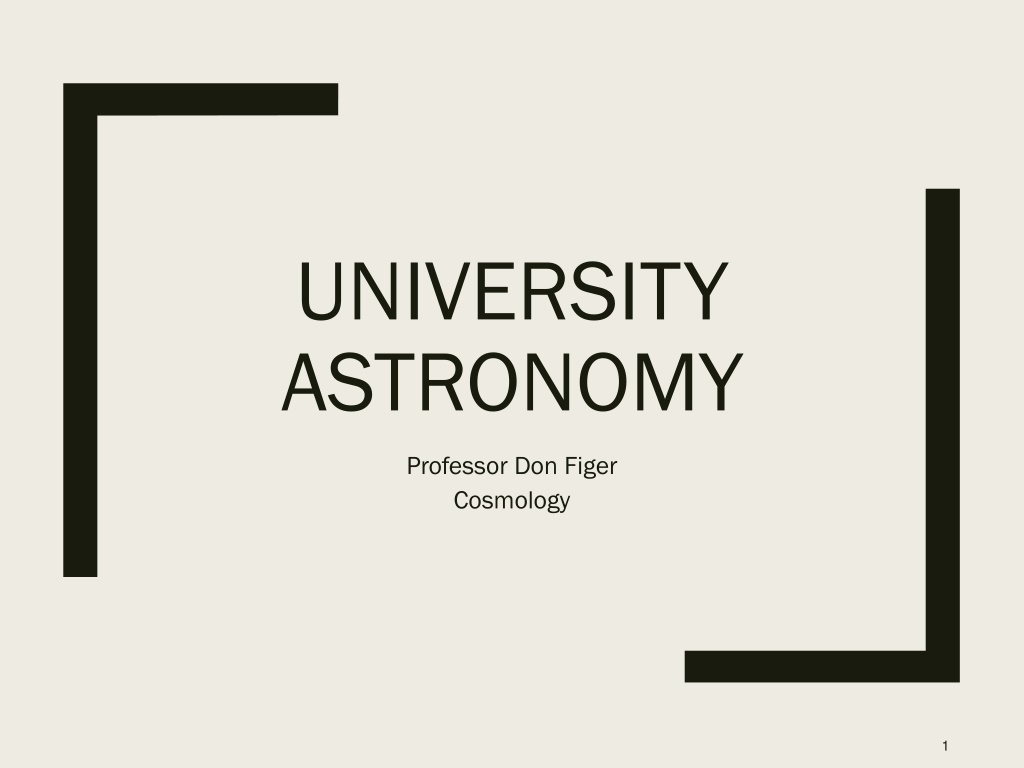

![READ⚡[PDF]✔ The Earth in Context: A Guide to the Solar System (Springer-Praxis S](/thumb/21508/read-pdf-the-earth-in-context-a-guide-to-the-solar-system-springer-praxis-s.jpg)
![[PDF⚡READ❤ONLINE] Cosmology and Particle Astrophysics (Wiley-Praxis Series in As](/thumb/21627/pdf-read-online-cosmology-and-particle-astrophysics-wiley-praxis-series-in-as.jpg)

